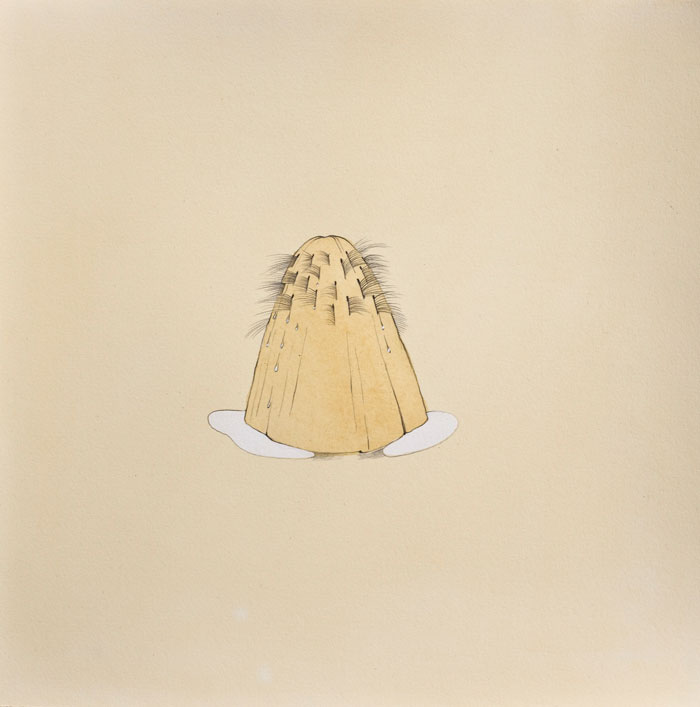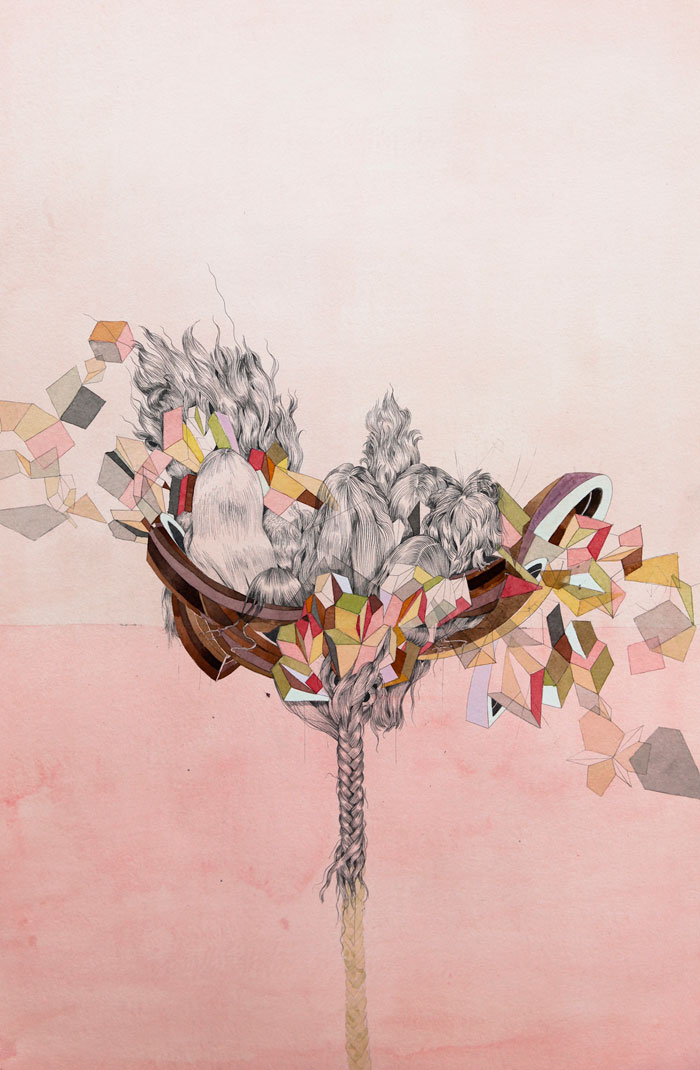
There is a deceptive simplicity to Bent’s drawings, and at first glance, their sense of whimsy overshadows their underbelly of methodical research. Bent thinks very deliberately about her place in the world, and this sense of inquiry carries over in a very literal way to the precision of her compositions.
“I like things that I respond to in a physical, aesthetic way,” she explains to me. “But as a person, I just really love to dig and dig and dig… I like it when there’s a whole series of layers underneath.”
After a brief miscommunication over directions that leads to a rather informative exploratory bicycle mission of the alleyways around Qwest Field, we meet in the high-ceilinged Pioneer Square studio that Bent shares with her husband, fellow artist Zack Bent. Bent and her husband create in different mediums, but she explains that they work together in that they are one another’s biggest critic and advocate, and that their strengths and weaknesses are staggered in complimentary ways. The artist couple has three young sons, so their lives involve a great deal of juggling between creative and family lives. Their paintings and sculptures stand in easy dialogue on separate ends of the room.
“We are both concerned with the architectural,” she tells me, gesturing towards the stacks of life-sized Lincoln Logs that rest on Zack’s side of the studio.
Bent’s compositions tend to focus on the interplay between angular and organic forms. Her drawings at times resemble tornadoes – densely clustered masses of line and plane that gradually open into light colored washes or entirely empty space.
“I very much idealize geometric abstraction,” Bent tells me, adding that her appreciation of the geometric has deepened over the years until she has come to see it as almost “a romantic ideal.” She sees the “furry” portions of her works as representing the more human, realistic side of life, the “faltering part… where everything cracks or falls apart.” Bent describes this idea in greater detail on her blog, writing that she is “fascinated by the idealistic glory of the philosophy of architecture, especially when it is brought into real space and has to sustain itself against the degrading process of time and use. The most fancy buildings still leak and peel. People still have to deposit their raw sewage inside them, and weather delivers continual erosion to their shells.”
ARTICLE CONTINUED BELOW

(ABOVE) I Am Focusing All My Attention, 2010; (BELOW) I Am Focusing All My Attention Detail, 2010 – G. Gibson Gallery


Paper Architecture: Reflecting Pool (I Smell Like Myself), 2011 – G. Gibson Gallery
While Bent is first and foremost an artist, her drawings are extremely linked to her identity as a writer, and her work is complemented by a detailed process blog that explores her wide range of influences. Bent is an artist with an enormous capacity for fascination, and her blog documents the diverse interests of someone who is perhaps less concerned with curiosity over specific things than with the idea of curiosity itself. Much like her drawing style, Bent writes with a lyrical fluidity that leads the reader between tangents in a way that makes leaps in topic seem entirely natural, perhaps even logical. In one entry, Bent begins with a description of phantom smells and segues into a rhapsodic description of her thought process on a stroll.
“I imagine as I walk that I’m parting a sea of orbs and domes,” she writes, “invisible wonders like the improbably beautiful jellies we see floating around in our aquatic oceans. Electron microscopes back me up.”
Bent is an artist whose work is firmly tied to a sense of place, and she has an older painting from her Midwest days pinned up on the wall of her studio. “I’m considering reworking it,” she tells me as she scrutinizes the piece. It’s fascinating to see all the ways in which the work tackles the same themes, but with an entirely different vocabulary. The painting is still concerned with the abstracted interaction of geometry and landscape, but she has not yet found her delicacy, and there is something almost shocking about the boldness of line in this older work juxtaposed with the obsessively dainty graphite patterns of Bent’s current endeavors. Bent tells me that many of her older pieces were composed with low horizons and huge skies, and she sees this as a direct response to the landscape she was raised in. She used to punctuate her landscapes with foreground details, because often the inspiration she was working from was “in fact quite ugly.”
While still living in the Midwest, Bent had recurring dreams about walking through her yard and suddenly finding herself in front of mountains. “They were good dreams, satisfying dreams,” she absentmindedly reminisces. “I had certain times [in my work] that I’d play with the idea of a mountain, but I just didn’t know them yet.”
When she moved to Seattle, her dreams of mountains were supplanted by the reality of their presence. “It’s a little bit embarrassing being a Northwest artist that works with mountains,” Bent laughs. “I can’t help it, it just keeps drawing me back. It’s a way of knowing, of figuring out where I am.”
She elaborates on this idea in her blog, writing that “living in Seattle under the watch of Mt. Rainier has also played into my imagination. And, in its way, it stands for my own persistent hunger to connect with something bigger than me, though there is an inherent frustration in this desire as well.”
Mountains come up repeatedly over the course of our conversation: Bent dreamt of them as abstractions from the flatlands of Indiana, and her current compositions are in large part informed by the mountain paintings of China’s Song dynasty. Out of frustration with what she saw as her static compositions, Bent turned to Chinese landscapes and became drawn to the idea of “hanging in mist and disappearing into the sky as a physical feeling.” It’s easy to see the Asian influence in the pieces she is currently working on, where landscapes and rivers double back upon themselves and recede into one another in a way that manages to be at once dynamic and fixed.
ARTICLE CONTINUED BELOW

(ABOVE) The aforementioned work-in-progress, a remainder of Bent’s Midwest days; (BELOW – LEFT) Hollowed And Hallowed, 2011; (BELOW – RIGHT) Top Of The World (Holy Mountain), 2009 – G. Gibson Gallery

Mountains are also a theme in Bent’s future. She is currently mulling over the idea of incorporating them into a 2012 exhibit at San Francisco’s Ampersand International. The show revolves around the idea of Venn diagrams, and Bent is exploring the overlap of the Olympic Mountain range’s Brothers Mountains. She explains that she is curious about the way that they share territory, and how they fade and recede into each other.
“I’m interested in the brothers because of my own sons,” Bent elaborates, “[in] the way their similarities and differences mesh between them.”
Like many artists who work in the nebulous space between fine art and illustration, Bent speaks with the careful deliberation of someone who is frequently called upon to define her territory.
“I’m called an illustrator very often,” she tells me, “and I completely understand where that comes from because my work is illustrative… but [what I do] doesn’t start with content and then illustrate that content, which is what illustration is.”
Bent pauses and explains that while she is interested in capturing a sense of narrative, her fascination lies more in the potential of where an unfinished storyline might go. She enjoys ambiguity because she “thinks that it’s a fun place for the mind to play, especially if there are enough clues that you can put together some sort of tension or a certain falling apart, where you can almost insert the next frame like in an animation.”
In addition to her own practice, Bent works as an illustration teacher at Seattle Pacific University. She loves the constant exchange of ideas and influences with her students, and enjoys being able to teach her students a methodological vocabulary. For someone with such trepidation over the art world’s tendency to classify her as an illustrator, Bent actively embraces the crossover of illustrative techniques into her own work. She is drawn to the technical, craft based aspect of illustration.
“A lot of times it’s a quality of line, a way of describing form, or organizing space — of giving you those little solar plexus hits,” she tells me. “Illustration proper is designed to be, for lack of a better word, manipulative. It’s designed to do something,” she says, punctuating her words with a sharp snap of her fingers.
ARTICLE CONTINUED BELOW

Ghost Of A Tether, 2010 – G. Gibson Gallery
Bent is similarly uncomfortable with a second word that is often used to describe her work: “surrealism.” She winces at the term and we embark on a tangent about how surrealism is such a charged word, and how it so quickly narrows the scope of any work it is used to describe. But Bent has a talent for playing devil’s advocate and sees the rationale in classifications she does not necessarily agree with. It seems that she is less irritated by the interpretation of her work as surreal than by the fact that the term surrealism has been so thoroughly co-opted by a specific aesthetic style that it creates preconceived notions about what a viewer is experiencing.
“My work is surreal in that I’m interested in dreams,” she concedes, “but it’s not about dreams. It’s not about that liminal space; it’s a lot more conscious. It’s really conscious.”
I ask Bent for her elevator speech, saying that if we can’t use the words “illustration” or “surreal,” it makes her work tricky to describe to people who have never seen it.
“Man, I need an elevator speech!” she laughs. “The elevator speech, if I really had to give it, would be really, really snooty. I think that, for me, it’s all about epistemology. It’s, ‘How do I know the world?’ So I draw in order to figure out how to know the world. It’s kind of lofty, but it’s really why I do it, and it’s what drives me and keeps me there.”
I mention that it only sounds lofty if taken out of context, and that to anyone who follows her blog, it seems like a very precise and reasonable description of what she’s after. In a sense, one has to read her source material to gain the full experience of her drawings.
“Yeah, I guess in that sense maybe what I’m doing is illustration,” Bent muses. “It’s the illustration of my thought process, my research.”
www.galabent.com
www.zackandgalabent.com

(ABOVE) Watcher Detail, 2010; (BELOW) Poor Thing…, 2011 – G. Gibson Gallery

(Editor’s note: Gala Bent offered us a comment and said: “Thank you, Tessa, for such an attentive ear and a new view for me onto my own work! I’m deeply honored. A mini-clarification, because the Midwestern landscape is actually like a beloved friend to me: when I talked about the “ugly” land I was most specifically talking about the post-agricultural suburban sprawl, where the land seems to have been stripped of its majesty, so that its gems are often hidden.”)







[…] http://www.redefinemag.com/2011/gala-bent-artist-interview/ […]